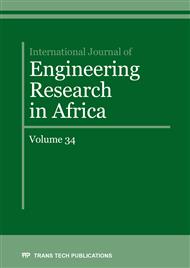[1]
M. Amir, H. Hamedi, Effect of waste plastic bottles on the stiffness and fatigue properties of modified asphalt mixes. Materials & Design. 61 (2014) 8-15.
DOI: 10.1016/j.matdes.2014.04.046
Google Scholar
[2]
K. Aravind, A. Das, Pavement design with central plant hot-mix recycled asphalt mixes. Construction and Building Materials. 21 5 (2007) 928-936.
DOI: 10.1016/j.conbuildmat.2006.05.004
Google Scholar
[3]
A. Saad, I Shatnawi, Prediction of bituminous mixture fatigue life based on accumulated strain. Construction and Building Materials. 21 no 6 (2007) 1370-1376.
DOI: 10.1016/j.conbuildmat.2005.09.004
Google Scholar
[4]
F. M Nejad, E. Aflaki, M.A. Mohammadi, Fatigue behavior of SMA and HMA mixtures. Construction and Building Materials. 24 no 7 (2010) 1158-1165.
DOI: 10.1016/j.conbuildmat.2009.12.025
Google Scholar
[5]
R. Pabitra, G. Engleng, Asphalt Stiffness Reduction and Stress-Strain Calculation in Pavement Structures. International Journal of Pavement Research and Technology. 8 5 (2015) 377-382.
Google Scholar
[6]
A. Veeraragavan, Dynamic mechanical characterization of asphalt concrete mixes with modified asphalt binders. Materials Science and Engineering. A 528 no 21 (2011) 6445-6454.
DOI: 10.1016/j.msea.2011.05.008
Google Scholar
[7]
H. Xiao-Di, L.F. Walubita. Influence of Asphalt-Binder Source on CAM Mix Rutting and Cracking Performance: A Laboratory Case Study. International Journal of Pavement Research and Technology. 8 no 6 (2015) 419-425.
Google Scholar
[8]
M. Amir, Investigating the toughness and fatigue behavior of conventional and SBS modified asphalt mixes. Construction and Building Materials. 47 (2013) 218-222.
DOI: 10.1016/j.conbuildmat.2013.05.044
Google Scholar
[9]
M. Ghasemi, M.S. Morteza, T. Majid, K.R. Jalal, T. Reza. Modification of stone matrix asphalt with nano-SiO2. J Basic Appl Sci Res. 2 no 2 (2012) 1338-44.
Google Scholar
[10]
G. Behnam, F.M. Nejad, S.S. Galooyak, Performance evaluation of linear and nonlinear nanocomposite modified asphalts. Construction and Building Materials. 35 (2012) 197-203.
DOI: 10.1016/j.conbuildmat.2012.03.010
Google Scholar
[11]
N.I. M Yusoff, A.A.S. Breem, H.N. Alattug, A. Hamim, J. Ahmad. The effects of moisture susceptibility and ageing conditions on nano-silica/polymer-modified asphalt mixtures. Construction and Building Materials. 72 (2014) 139-147.
DOI: 10.1016/j.conbuildmat.2014.09.014
Google Scholar
[12]
P.K. Ashish, D. Singh, S. Bohmb. Evaluation of Rutting, Fatigue and Moisture Damage Performance of Nanoclay Modified Asphalt Binder. Construction and Building Materials 113 (2016) 341-350.
DOI: 10.1016/j.conbuildmat.2016.03.057
Google Scholar
[13]
ASTM D 70 Standard Test Method for Specific Gravity and Density of Semi-Solid Bituminous Materials (Pycnometer Method), Annual Book of ASTM Standards 4. 03, West Conshohocken, PA: ASTM International. (2003).
DOI: 10.1520/d0070-03
Google Scholar
[14]
ASTM Standard D5. Standard Test Method for Penetration of Bituminous Materials. ASTM International, West Conshohocken. USA. (2006).
Google Scholar
[15]
ASTM Standard D36. Standard Test Method for Softening Point of Bitumen (Ring-and-Ball Apparatus). ASTM International, West Conshohocken. USA. (2009).
Google Scholar
[16]
ASTM D 4402Standard Test Method for Viscosity Determination of Asphalt at Elevated Temperatures Using a Rotational Viscometer, Annual Book of ASTM Standards 4. 04, West Conshohocken, PA: ASTM International. (2006).
DOI: 10.1520/d4402_d4402m-23
Google Scholar
[17]
Z. Dong, S. Hou, J. Bian, L. He. Investigation of the micro-cracking behavior of asphalt mixtures in the indirect tensile test. Engineering Fracture Mechanics. 163 (2016) 416-425.
DOI: 10.1016/j.engfracmech.2016.05.020
Google Scholar
[18]
M. Amir, H. Hamedi. Developing laboratory fatigue and resilient modulus models for modified asphalt mixes with waste plastic bottles (PET). Construction and Building Materials. 68 (2014) 259-267.
DOI: 10.1016/j.conbuildmat.2014.06.054
Google Scholar
[19]
E. Iskender. Evaluation of mechanical properties of nano-clay modified asphalt mixtures. Measurement. 93 (2016) 359-371.
DOI: 10.1016/j.measurement.2016.07.045
Google Scholar
[20]
NIM. Yusoff, Nur Izzi Md, A. Breem, H. Alattug, A. A. Hamim, A. Juraidah. The effects of moisture susceptibility and ageing conditions on nano-silica/polymer-modified asphalt mixtures. Construction and Building Materials. 72 (2014) 139-147.
DOI: 10.1016/j.conbuildmat.2014.09.014
Google Scholar
[21]
L. D. Poulikakos, M. N. Partl. Evaluation of moisture susceptibility of porous asphalt concrete using water submersion fatigue tests. Construction and Building Materials. 23 no 12 (2009) 3475-3484.
DOI: 10.1016/j.conbuildmat.2009.08.016
Google Scholar


